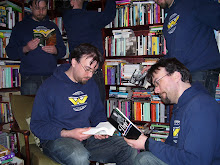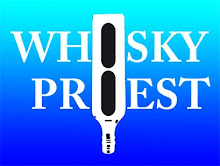As a follow-up to yesterday's posting of the Penguin Legends of the Ancient North covers, here they are in their final, high-resolution versions: please click for nice big versions. They are the work of Petra Borner (previously discussed here and here), and were made of layered papercuts at a startling A2 scale. As for the stickers mentioned in that last post, Penguin's art editor, Isabelle De Cat, is very reassuring: "it does peel off, and it does peel off super-neatly: I made absolutely sure of that. I’ve been testing all the stickers the production controller could source until we found the perfect thing that will not damage the covers." So I'll be buying all five, then! (And for more amazing papercut illustrations, see this old post...)
Thursday 20 June 2013
Tuesday 18 June 2013
Father Brown, Ancient North
A brief post showing off two new series coming from Penguin Classics UK at the end of the year: first of all, the five books in the 'Legends from the Ancient North' series:
These are really nice, with an air of olden-days Penguins to them. I just hope that this bit...
..is a sticker, or else you'll be permanently stuck with that unfortunate link to the middle bits of the most drawn-out case of milking it in cinematic history.
The other series are these elegant new editions of the G. K. Chesterton Father Brown books:
These take inspiration from Romek Marber's old Penguin Chesterton crime covers, especially in the case of 'The Incredulity...' (old) in 'The Innocence...' (new):
Tuesday 11 June 2013
Describing the story and tone within one or two inches: An interview with Andrea Uva
Some publishers have not let the advent of ebooks kill their
design instincts. Open Road Integrated Media publish a lot of digital-format
books, and have the rights to the backlists of a lot of great writers, both “literary”
and in various genres. I talked to Andrea C. Uva, Art Director at Open Road, about
the unique challenges and possibilities of ebook cover design.
* * *
CAUSTIC COVER CRITIC: I’d imagine browsers in bookshops can
stumble on a physical book serendipitously a lot more easily than they can an
ebook, which is often something they need to seek out to find. Does this mean
the challenge of cover design for ebooks is different?
ANDREA C. UVA: Yes,
browsers in a bookstore are much more of a captive audience. Even if a person
goes straight to an employee to request a book, he or she still must pass
through tables and shelves before arriving at the book’s location, and there
will be many more titles all around. On an ebook website, one simply types in
the book title or author name and up pops the title. That system creates a lot
less exposure. The digital platform means that viewers are exposed to fewer book
covers than they would be in a bookstore, but that playing field is leveled
because all ebooks are presented on an e-tailer site at almost the same size.
Print-production marketing tricks like spot gloss, matte finishes, embossing,
gold foil, hardcover opulence, etc., are lost on the digital platform. The
reader can’t even tell how “thick” their ebook is, another clue that would give
a sense of value from one book to the next. This means that ebook cover
designers need to make covers that are appealing and call to the reader from
the “shelf” without any additional dressings, and at a very small size. Most
ebooks are displayed at about one to two inches high on an ebook retailer site.
This means that in order to sell our books, titles must be made as large as
possible to be readable at thumbnail size. Ebook covers are not a place for
subtle art, either. The concept must be clear at a small size and not obstruct
the type. It is much more difficult to be evocative within these
parameters.
 |
| Cover by Mauricio Diaz |
.jpg) |
| Covers by Michel Vrana |
CAUSTIC COVER CRITIC: A lot of the Open Road covers use
lovely, rich colours that glow on a computer screen in a way that a non-backlit
printed cover cannot do (such as the beautiful popping colours on Pete Hautman's
‘Drawing Dead’). Is the “screen-ness” of images and designs a factor in OR
covers, or do you think the books would have the same look if destined for
printed form?
 |
| Covers by Connie Gabbert |
CAUSTIC COVER CRITIC: I’ve noticed that very few OR covers feature
the sort of blurbs and “from the author-of”s that feature on many book covers.
What's the rationale behind this?
ANDREA C. UVA: Ebooks offer
the opportunity to feature a blurb of selling text next to the cover, which
serves as a digital back cover or inside jacket flap. This means that
information that would normally go on a print cover, like quotes or blurbs, can
live right next to the book and still make it to the reader. Print book covers
have a lot more room for this type of information because the reader is looking
from inches away, and doesn’t need the cover type to be large. On an ebook,
anything below about a twenty-four-point font can get lost in thumbnail size,
and a very small-set quote or blurb mostly clutters an ebook cover and covers
up the art rather than enhancing the book. For that reason, we do our best to
streamline the amount of text on an ebook cover, reserving quotes, praise, and
other info to the metadata that runs alongside it on the retailer site.
 |
| Covers by Angela Goddard |
CAUSTIC COVER CRITIC: A huge selection of OR books are
backlist titles, often the complete or near-complete works of certain authors.
What informs the design of a set of linked covers (say the Fred Kaplan or Fay
Weldon backlists)? What can or can't you do, compared to working on a cover for
a book that has no design connections with other titles by that author?
ANDREA C. UVA: Open
Road has been breaking that convention from the beginning, and we’re very proud
of the progress we’ve made in this area. In the past, book covers that shared
the same author were designed one at a time, sometimes years apart depending on
the books’ publication schedules, and according to the aesthetic sensibility of
the particular year or era in which they were written. This results in a very
disjointed backlist from an author, and designing a book according to the type
and image design trends of the year in which the designer is working doesn’t
always best serve the book or the author. Since we at Open Road consider
ourselves a digital marketing company as much as a digital publisher, creating
a unified marketing front for a collection of books by an author is a priority.
We approach our authors as traditional marketing companies approach brands, and
the way that manifests itself in the design is that the author’s name becomes
their logo, and the look of one of their books becomes the look of their entire
list. Though many of the books in a particular author’s backlist might not
share the same characters, settings, or story details, they are connected by
their writer, and that is what we draw upon when we create a redesigned
backlist that unifies the titles visually. Within those parameters, there is lots
of room to use imagery to differentiate time, place, and other details that set
the books apart.
 |
| Covers by Angela Goddard |
 |
| Covers by Angela Goddard |
CAUSTIC COVER CRITIC: What's your own design background? How
did you come to working with ebooks in particular?
ANDREA C. UVA: I have
a background that is split between graphic design and conceptual art. I have
been designing and typesetting books, magazines, and newspapers on computers in
some form since 1996, but my career in publishing began in 2003 at Simon &
Schuster in New York City. At this time, ebooks were not a player. My design
career in terms of books has been mostly print. I worked for a book packager
that allowed me to design book covers for many publishers, including Harper
Collins, Little, Brown and Company, Scholastic, Simon & Schuster, Penguin,
and Sourcebooks, and I gained a broad understanding of cover-design aesthetics
and how they vary from publisher to publisher. I also have experience in web
design, and ebook covers are the merger of the more commercial print-book
design with the technical aspects of web design. Coming to it from a conceptual
education background has been integral in solving the particular challenge that
ebook covers provide: describing the story and tone within a thumbnail
parameter of one to two inches and presenting it in a way that the viewer can
easily see and understand.
CAUSTIC COVER CRITIC: Ignoring budgetary constraints,
publishing rights, and any other annoying details--is there a book you'd kill
to have the chance to design a cover for?
ANDREA C. UVA: That’s
a great question! Iconic books and iconic covers tend to grow organically. Very
few bestsellers come out knowing they are destined for fame. This is why the
iconic book art for many of our most beloved titles isn’t always the most
clear, or even the best designed, but after time and the sales of many
editions, they take on a life of their own. Look at Twilight, for example, or The
Great Gatsby. To answer your question, I think it would be difficult to
come at a book that is so well known and means so much to so many people and
try to slap one cover on it that would meet everyone’s expectations. I would
much prefer to work on an unknown book that becomes a best-loved classic, and
have that original cover that I designed live on in infamy. To me that seems
more true to the spirit of the book and to art than to try to rebrand a
blockbuster title to suit the needs of everyone. If I had to name a book to
redesign, it would probably be Les Misérables,
as I think there is an opportunity for a graphic treatment that is referential
to the plight of the characters.
CAUSTIC COVER CRITIC: Thank you, Ms Uva!
Tuesday 4 June 2013
1970s Hair
Many moons ago I raved about one of the best first novels I've read, Martine McDonagh's I Have Waited, And You Have Come, a wonderfully unsettling post-climate-change novel of obsessive love and constant rain. McDonagh has just had a second novel published, After Phoenix, and it's also excellent. Given that the book's subject is grief, and that grief is a dulling, leaden, grey and tedious feeling, it's amazing how vital, entertaining and even funny After Phoenix is, without in any way shortchanging the reality of the experience.
It's also blessed with a great cover by John Davison.
I really like the mix of sketchy, wonky lines with photographic textures: it has something of Nicholas Motte about it, and is very effective. The book itself is from Ten to Ten Publishing, a new publishing house.
It's also blessed with a great cover by John Davison.
 |
| Click to embiggenise |
I really like the mix of sketchy, wonky lines with photographic textures: it has something of Nicholas Motte about it, and is very effective. The book itself is from Ten to Ten Publishing, a new publishing house.
Subscribe to:
Posts (Atom)



















.jpg)
.jpg)
.jpg)











+(1).jpg)
+(2).jpg)










